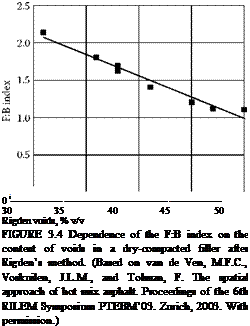Mortar—F:B Index
One popular approach used during design practice in many countries is to indicate the recommended range of the filler-bitumen ratio (or F:B index) by weight or volume. Researchers in the United States have said that this factor better describes the maximum content of filler in the mix than does setting specific limits on the filler content. It is also worth adding that those studies have defined the maximum F:B index for asphalt concrete at the level of 1.2-1.5 (by weight) (Anderson, 1987). The F:B index was later altered to 0.6-1.6 in the Superpave method (Superpave Mixture Design Guide. WesTrack Forensic Team Consensus Report, 2001). Finally the suggested F:B ratio for SMA mixes is at 1.5 by weight, taking the total amount of dust on aggregates and added filler as the filler content (Harris and Stuart, 1995). But the F:B index has been criticized for some time, and there are suggestions regarding its replacement by other factors based on the free binder concept. As an example, Australian research studies (Bryant, 2006) suggest the application of an additional filler fixing factor (FFF) apart from the F:B index. Tests have proved that FFF may be also used to estimate the workability of a mixture.
It is necessary to remember that fillers differ markedly in terms of gradation, density, and void content, therefore formulating a universal F:B index is only an approximation. In fact, such an index should be defined for each filler individually. The goal is clear for each case—to produce a mastic that is neither too dry nor too soft.
Figure 3.4 illustrates the relationship between the content of voids in fillers according to Rigden’s method and the amount of filler needed to fix binder completely. The higher the F:B index, the more filler is needed to fix the binder. This relationship is illustrated by the graph; the estimated line of completely filled voids in the filler represents the zero-amount of free binder—all the binder is fixed.
As we can see, to fix the binder we need roughly two times more filler that has approximately 30% free voids (the lowest content according to Rigden) than filler that has 50% voids. In the latter case, less filler is sufficient to accommodate all the binder in the free voids (there is a lot of free space for binder within the high void content). It would be difficult for us to use such dependencies unless the filler manufacturer supplies data on the content of free voids according to Rigden or we conduct suitable tests ourselves. All in all, it is better to perform the tests in our own laboratories since eventually a voids parameter may be applied to the entire filler fraction of a mixture (i. e., including the filler fraction that may be coating the coarse and fine aggregate particles).
Another way to evaluate the properties of mortars and the F:B ratio is the application of the softening point (SP) method. According to a publication from Germany (Schroeder and Kluge, 1992) mortars with SPs between 85°C and 100°C perform

well in SMA. Also the Superpave binder test methods could be used for mortar testing (DSR[15] and BBR). In Chapter 8, one can find a short description of the methods and some additional remarks.






Leave a reply